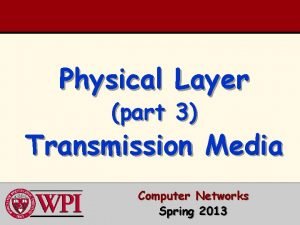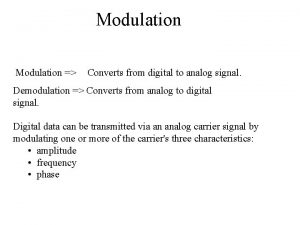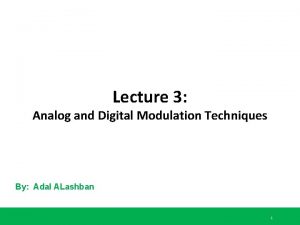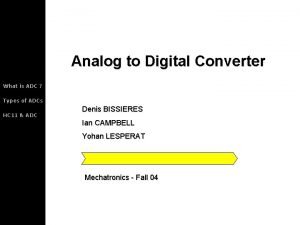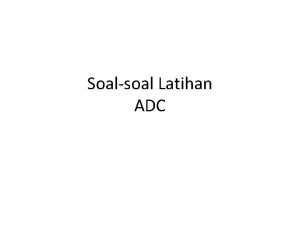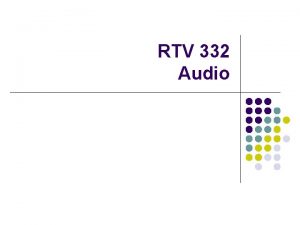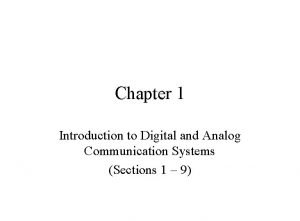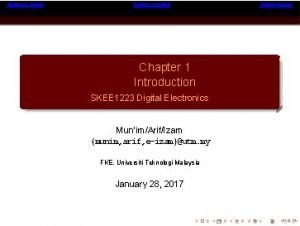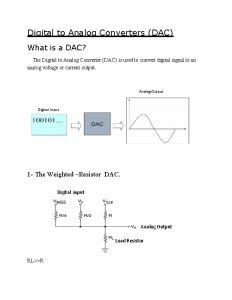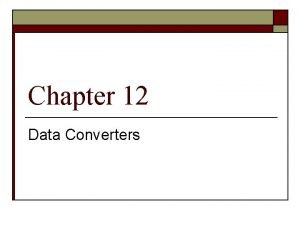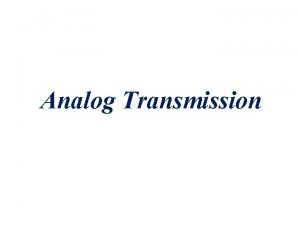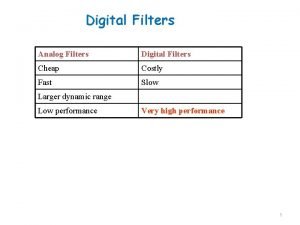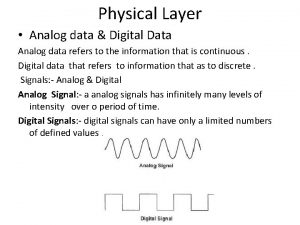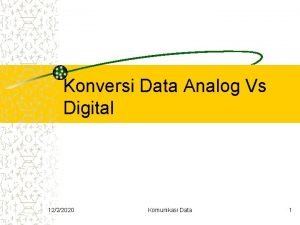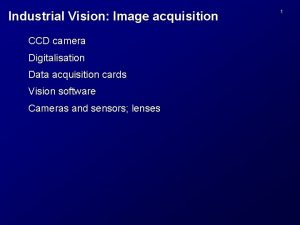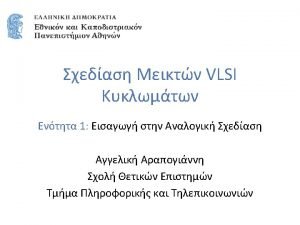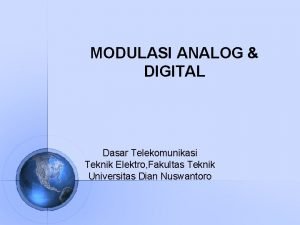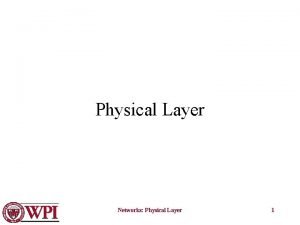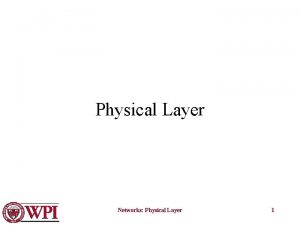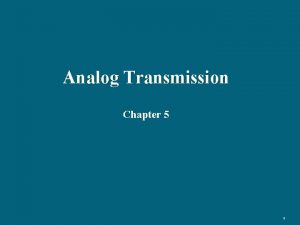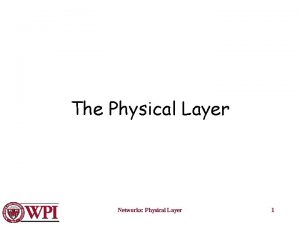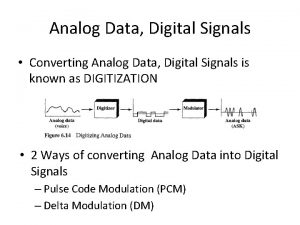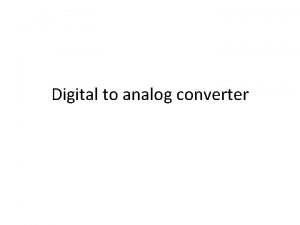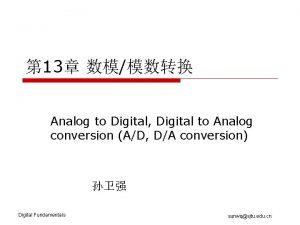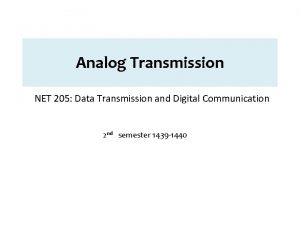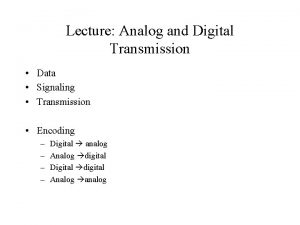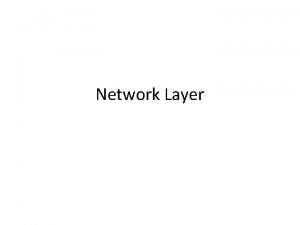MODULE 2 Digital Transmission Physical Layer Analog Transmission








































- Slides: 40

MODULE 2: Digital Transmission Physical Layer Analog Transmission 1 Department of Computer Science, BLDEACET

Chapter 4 Digital Transmission Department of Computer Science, BLDEACET 2

Introduction A computer network is designed to send information from one point to another. This information needs to be converted to either a digital signal or an analog signal for transmission. In this chapter, we show the schemes and techniques that we use to transmit data digitally. First, we discuss digital-to-digital conversion techniques, methods which convert digital data to digital signals. Second, we discuss analog-to-digital conversion techniques, methods which change an analog signal to a digital signal. Finally, we discuss transmission modes. 3 Department of Computer Science, BLDEACET

DIGITAL-TO-DIGITAL CONVERSION In Chapter 3, we discussed data and signals. We said that data can be either digital or analog. We also said that signals that represent data can also be digital or analog. In this section, we see how we can represent digital data by using digital signals. The conversion involves three techniques: line coding, block coding, and scrambling. Line coding is always needed; block coding and scrambling may or may not be needed. 4 Department of Computer Science, BLDEACET

Line Coding Line coding is the process of converting digital data to digital signals. We assume that data, in the form of text, numbers, graphical images, audio, or video, are stored in computer memory as sequences of bits. Line coding converts a sequence of bits to a digital signal. At the sender, digital data are encoded into a digital signal; at the receiver, the digital data are recreated by decoding the digital signal. Figure below shows the process. Figure: Line coding and decoding 5 Department of Computer Science, BLDEACET

Characteristics Before discussing different line coding schemes, we address their common characteristics. Signal Element Versus Data Element Let us distinguish between a data element and a signal element. In data communications, our goal is to send data elements. A data element is the smallest entity that can represent a piece of information: this is the bit. In digital data communications, a signal element carries data elements. In other words, data elements are what we need to send; signal elements are what we can send. Data elements are being carried; signal elements are the carriers. 6 Department of Computer Science, BLDEACET

Signal Element Versus Data Element Figure: Signal element versus data element 7 Department of Computer Science, BLDEACET

Cntd… In part a of the figure, one data element is carried by one signal element (r = 1). In part b of the figure, we need two signal elements (two transitions) to carry each data element (r =1/2) In part c of the figure, a signal element carries two data elements (r = 2). Finally, in part d, a group of 4 bits is being carried by a group of three signal elements (r = 4/3). For every line coding scheme we discuss, we will give the value of r. 8 Department of Computer Science, BLDEACET

Data Rate Versus Signal Rate The data rate defines the number of data elements (bits) sent in 1 s. The unit is bits per second (bps). The signal rate is the number of signal elements sent in 1 s. The unit is the baud. The data rate is sometimes called the bit rate; the signal rate is sometimes called the pulse rate, the modulation rate, or the baud rate. One goal in data communications is to increase the data rate while decreasing the signal rate. Increasing the data rate increases the speed of transmission; decreasing the signal rate decreases the bandwidth requirement. In our vehicle-people analogy, we need to carry more people in fewer vehicles to prevent traffic jams. 9 Department of Computer Science, BLDEACET

Line Coding Schemes Figure: Line coding schemes 10 Department of Computer Science, BLDEACET

Unipolar Scheme Unipolar NRZ Scheme Figure: Unipolar NRZ scheme In a unipolar scheme, all the signal levels are on one side of the time axis, either above or below. NRZ (Non-Return-to-Zero): Traditionally, a unipolar scheme was designed as a non-return-to zero (NRZ) scheme in which the positive voltage defines bit 1 and the zero voltage defines bit 0. It is called NRZ because the signal does not return to zero at the middle of the bit. Figure above show a unipolar NRZ scheme. 11 Department of Computer Science, BLDEACET

Polar Scheme Polar NRZ-L and NRZ-I schemes Figure: Polar NRZ-L and NRZ-I schemes In polar schemes, the voltages are on the both sides of the time axis. For example, the voltage level for 0 can be positive and the voltage level for 1 can be negative. 12 Department of Computer Science, BLDEACET

Cntd… Polar RZ Scheme Figure: Polar RZ scheme In RZ, the signal changes not between bits but during the bit. In Figure above we see that the signal goes to 0 in the middle of each bit. It remains there until the beginning of the next bit. 13 Department of Computer Science, BLDEACET

Cntd… Polar Biphase: Manchester and Differential Manchester Figure: Polar biphase: Manchester and differential Manchester schemes The idea of RZ (transition at the middle of the bit) and the idea of NRZ-L are combined into the Manchester scheme. In Manchester encoding, the duration of the bit is divided into two halves. The voltage remains at one level during the first half and moves to the other level in the second half. 14 Department of Computer Science, BLDEACET

Cntd… Differential Manchester, on the other hand, combines the ideas of RZ and NRZ-I. There is always a transition at the middle of the bit, but the bit values are determined at the beginning of the bit. If the next bit is 0, there is a transition; if the next bit is 1, there is none. Figure above shows both Manchester and differential Manchester encoding. 15 Department of Computer Science, BLDEACET

Bipolar Scheme Figure: Bipolar schemes: AMI and pseudoternary In bipolar encoding (sometimes called multilevel binary), there are three voltage levels: positive, negative, and zero. The voltage level for one data element is at zero, while the voltage level for the other element alternates between positive and negative. Figure above shows two variations of bipolar encoding: AMI and pseudoternary. 16 Department of Computer Science, BLDEACET

Cntd… A common bipolar encoding scheme is called bipolar alternate mark inversion (AMI). In the term alternate mark inversion, the word mark comes from telegraphy and means 1. So AMI means alternate 1 inversion. A neutral zero voltage represents binary 0. Binary 1 s are represented by alternating positive and negative voltages. A variation of AMI encoding is called pseudoternary in which the 1 bit is encoded as a zero voltage and the 0 bit is encoded as alternating positive and negative voltages. 17 Department of Computer Science, BLDEACET

ANALOG-TO-DIGITAL CONVERSION The tendency today is to change an analog signal to digital signal. We have two techniques, pulse code modulation and delta modulation. Topics discussed in this section: Pulse Code Modulation (PCM) 18 Department of Computer Science, BLDEACET

Pulse Code Modulation Figure: Components of PCM encoder 19 Department of Computer Science, BLDEACET

Pulse Code Modulation The most common technique to change an analog signal to digital data (digitization) is called pulse code modulation (PCM). A PCM encoder has three processes, as shown in Figure above. 1. ) The analog signal is sampled. 2. ) The sampled signal is quantized. 3. ) The quantized values are encoded as streams of bits. . 20 Department of Computer Science, BLDEACET

Sampling The first step in PCM is sampling. The analog signal is sampled every Ts s, where Ts is the sample interval or period. The inverse of the sampling interval is called the sampling rate or sampling frequency and denoted by fs where fs = 1/Ts There are three sampling methods—ideal, natural, and flat-top as shown in figure below: 21 Department of Computer Science, BLDEACET

Sampling In ideal sampling, pulses from the analog signal are sampled. This is an ideal sampling method and cannot be easily implemented. In natural sampling, a high-speed switch is turned on for only the small period of time when the sampling occurs. The result is a sequence of samples that retains the shape of the analog signal. The most common sampling method, called sample and hold, however, creates flat top samples by using a circuit. 22 Department of Computer Science, BLDEACET

Sampling Rate q One important consideration is the sampling rate or frequency. What are the restrictions on Ts ? This question was elegantly answered by Nyquist. q According to the Nyquist theorem, to reproduce the original analog signal, one necessary condition is that the sampling rate be at least twice the highest frequency in the original signal. Note According to the Nyquist theorem, the sampling rate must be at least 2 times the highest frequency contained in the signal. 23 Department of Computer Science, BLDEACET

Sampling Rate Example 4. 6 For an intuitive example of the Nyquist theorem, let us sample a simple sine wave at three sampling rates: fs = 4 f (2 times the Nyquist rate), fs = 2 f (Nyquist rate), and fs = f (one-half the Nyquist rate). Figure below shows the sampling and the subsequent recovery of the signal. ü It can be seen that sampling at the Nyquist rate can create a good approximation of the original sine wave (part a). ü Oversampling in (part b) can also create the same approximation, but it is redundant and unnecessary. ü Sampling below the Nyquist rate (part c) does not produce a signal that looks like the original sine wave. 24 Department of Computer Science, BLDEACET

Sampling Rate 25 Department of Computer Science, BLDEACET

Quantization q The result of sampling is a series of pulses with amplitude values between the maximum and minimum amplitudes of the signal. q The quantization code is assigned for each sample based on the quantization levels 26 Department of Computer Science, BLDEACET

Encoding q The last step in PCM is encoding. After each sample is quantized and the number of bits per sample is decided, each sample can be changed to an n-bit code word. 27 Department of Computer Science, BLDEACET

PCM Decoder Figure : Components of a PCM decoder 28 Department of Computer Science, BLDEACET

Original Signal Recovery The recovery of the original signal requires the PCM decoder. The decoder first uses circuitry to convert the code words into a pulse that holds the amplitude until the next pulse. After the staircase signal is completed, it is passed through a lowpass filter to smooth the staircase signal into an analog signal. 29 Department of Computer Science, BLDEACET

Example We want to digitize the human voice. What is the bit rate, assuming 8 bits per sample? Solution: The human voice normally contains frequencies from 0 to 4000 Hz. So the sampling rate and bit rate are calculated as follows: 30 Department of Computer Science, BLDEACET

TRANSMISSION MODES The transmission of binary data across a link can be accomplished in either parallel or serial mode. In parallel mode, multiple bits are sent with each clock tick. In serial mode, 1 bit is sent with each clock tick. While there is only one way to send parallel data, there are three subclasses of serial transmission: asynchronous, and isochronous. Topics discussed in this section: Parallel Transmission Serial Transmission 31 Department of Computer Science, BLDEACET

Data transmission and modes Figure : Data transmission and modes 32 Department of Computer Science, BLDEACET

Parallel transmission Figure : Parallel transmission 33 Department of Computer Science, BLDEACET

Cntd. . Binary data, consisting of 1 s and 0 s, may be organized into groups of n bits each. The mechanism for parallel transmission is a conceptually simple one: Use n wires to send n bits at one time. That way each bit has its own wire, and all n bits of one group can be transmitted with each clock tick from one device to another. Figure above shows how parallel transmission works for n =8. The advantage of parallel transmission is speed. But there is a significant disadvantage: cost. Parallel transmission requires n-communication lines (wires) just to transmit the data stream. Because this is expensive, parallel transmission is usually limited to short distances. 34 Department of Computer Science, BLDEACET

Serial transmission Figure : Serial transmission 35 Department of Computer Science, BLDEACET

Cntd. . In serial transmission one bit follows another, so we need only one communication channel rather than ‘n’ to transmit data between two communicating devices. The advantage of serial over parallel transmission is that with only one communication channel, serial transmission reduces the cost of transmission over parallel. Since communication within devices is parallel, conversion devices are required at the interface between the sender and the line (parallel-to-serial) and between the line and the receiver (serial-to-parallel). Serial transmission occurs in one of three ways: asynchronous, and isochronous. 36 Department of Computer Science, BLDEACET

Asynchronous transmission Figure: Asynchronous transmission q In asynchronous transmission, information is received and translated by agreed upon patterns. As long as those patterns are followed, the receiving device can retrieve the information without regard to the rhythm in which it is sent. q In asynchronous transmission, we send 1 start bit (0) at the beginning and 1 or more stop bits (1 s) at the end of each byte. There may be a gap between each byte. 37 Department of Computer Science, BLDEACET

Synchronous transmission Figure: Synchronous transmission q In synchronous transmission, the bit stream is combined into longer “frames, ” which may contain multiple bytes. Each byte, however, is introduced onto the transmission link without a gap between it and the next one. q It is left to the receiver to separate the bit stream into bytes for decoding purposes. q In synchronous transmission, we send bits one after another without start or stop bits or gaps. It is the responsibility of the receiver to group the bits. 38 Department of Computer Science, BLDEACET

Isochronous transmission In real-time audio and video, in which uneven delays between frames are not acceptable, synchronous transmission fails, the entire stream of bits must be synchronized. The isochronous transmission guarantees that the data arrive at a fixed rate. 39 Department of Computer Science, BLDEACET

END of Chapter 4 40 Department of Computer Science, BLDEACET
 Analog vs digital
Analog vs digital Physical layer transmission media
Physical layer transmission media كبيل
كبيل Compare and contrast analog and digital forecasts.
Compare and contrast analog and digital forecasts. Pengertian teknologi digital dan analog
Pengertian teknologi digital dan analog Analog vs digital
Analog vs digital Modulation digital to analog
Modulation digital to analog Analog and digital modulation techniques
Analog and digital modulation techniques Introduction to digital video
Introduction to digital video Whats an analog
Whats an analog Amw hübsch
Amw hübsch What is adc
What is adc Adc types
Adc types Kepanjangan adc
Kepanjangan adc Contoh soal sinyal analog
Contoh soal sinyal analog Rtv 332
Rtv 332 Digital signal as a composite analog signal
Digital signal as a composite analog signal Analog vs digital communication systems
Analog vs digital communication systems Analog chapter 1
Analog chapter 1 Analog image and digital image
Analog image and digital image Sebutkan 2 kelemahan modulasi digital
Sebutkan 2 kelemahan modulasi digital Digital to analog converter
Digital to analog converter Analogue and digital transmission in computer networks
Analogue and digital transmission in computer networks Digital to analog converters basic concepts
Digital to analog converters basic concepts Analog vs digital video
Analog vs digital video Digital to analog conversion in data communication
Digital to analog conversion in data communication Digital and analog quantities
Digital and analog quantities Digital to analog encoding
Digital to analog encoding Tap digital
Tap digital Advantages of digital computers
Advantages of digital computers Analog data and digital data
Analog data and digital data Analog vs digital
Analog vs digital Kelebihan elektronika analog
Kelebihan elektronika analog Compare analog and digital filters
Compare analog and digital filters Digital image acquisition for analog sem
Digital image acquisition for analog sem Introduction to digital control
Introduction to digital control Razavi cmos analog circuit design
Razavi cmos analog circuit design Compare and contrast analog and digital forecasting
Compare and contrast analog and digital forecasting Modulasi adalah
Modulasi adalah Pigmented layer and neural layer
Pigmented layer and neural layer Brush border enzymes
Brush border enzymes


